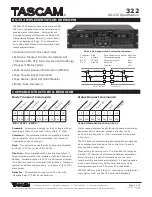
Satellite receiver:
The signals received and converted by the
LNB
cannot be used by the television. The satellite receiver re-processes
the signals so that its outputs provide common audio and video signals (
AV
) that can be transferred to the television.
SCART:
Connector on television sets, video cassette recorders, satellite receivers and other consumer electronic equipment
used to produce audio and video signals (AV).
Sensor
Produces impulses during a reflector movement that the receiver uses to calculate the reflector position.
Skew
Offset angle of the polarizer. The skew parameter’s value is fairly proportional to the angle of the receive signal in
degrees.
Timer:
Programmable device that enables the receiver to switch to a desired channel for a defined period of time.
TV:
Television set.
TWIN LNB:
LNB with two outputs that allows independent operation of two satellite receivers (=2V/H LNBs).
Subcarrier:
Carrier frequencies for television sound or radio channels which are broadcast together with the television picture; a
stereo channel requires two subcarriers, e.g. 7.38 and 7.56 MHz.
V/H LNB:
LNB which allows the reception of both
polarisation levels
on one or two
frequency ranges
. The s
upply voltage
of
14/18V (18V = horizontal level, 14V = vertical level) switches between polarities, the 22 kHz
modulation
toggles
between the frequency ranges (off = 11 GHz range, on = DBS range and 12.5 GHz range).
VCR:
Video cassette recorder
Supply voltage:
LNBs are powered via the
coax cable
; in addition, the receiver transfers a voltage of 14 or 18 volts.
Vertical polarisation:
See polarisation level
Intermediate frequency:
The
frequency range
used for satellite broadcasts cannot be transported over cabling systems; this is why the LNB
converts these frequencies to an intermediate range between 950 and 2050 MHz. This makes frequency transfer and
processing in the
receiver
possible.
1. IF
= Intermediate frequency
45
*M-Focus 2.6.95 14.12.1999 10:39 Uhr Seite 45




































